Robinhood Markets Bundle
Who is Trading on Robinhood?
Robinhood Markets revolutionized investing by offering commission-free trading, but who exactly makes up its user base? The platform, launched in 2013, aimed to democratize finance, but its success hinges on understanding its Robinhood Markets SWOT Analysis and, critically, its customer demographics. Unveiling the Robinhood target market and Robinhood user profile is key to grasping the company's strategy and impact.
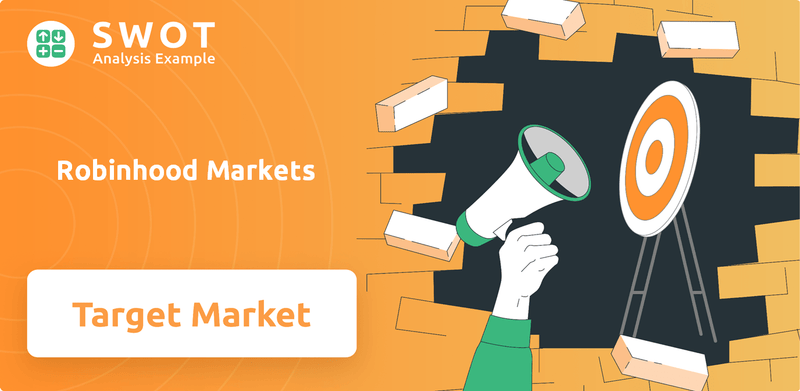
Delving into the customer demographics Robinhood attracts reveals valuable insights into investment trends and market dynamics. Analyzing the Robinhood investors, their age, income, and investment behaviors, provides a comprehensive view. Understanding the Robinhood audience helps to decipher the factors influencing their investment decisions, from the geographic location of Robinhood users to their education levels, ultimately defining Robinhood's ideal customer profile.
Who Are Robinhood Markets’s Main Customers?
Understanding the customer demographics of Robinhood is crucial for grasping its market position and strategic direction. The platform, known for its commission-free trading, has primarily attracted a younger demographic, particularly millennials and Gen Z. This user profile is drawn to the platform's ease of use and accessibility, making it a popular choice for those new to investing.
The Robinhood target market has historically been characterized by individuals with lower to middle incomes, who may not have had access to traditional financial services. The platform's simplified approach to investing has resonated with those new to financial markets, regardless of extensive financial education. This focus on accessibility has been a key driver of its growth and appeal within the investment community.
As of late 2023 and early 2024, Robinhood continues to evolve, with efforts to broaden its appeal and retain its user base. This includes introducing new features and services, such as retirement accounts, to attract a wider range of investors. The company's customer acquisition strategy often aligns with periods of heightened interest in specific asset classes, such as cryptocurrency.
The age range of Robinhood users skews younger, with a significant portion falling within the 25-40 age bracket. This demographic is attracted to the platform's user-friendly interface and commission-free trading model. This user profile is a key factor in the company's success.
Robinhood has traditionally attracted individuals with lower to middle incomes, providing access to investment opportunities. The platform's commission-free trading and accessible interface have lowered the barrier to entry. This has made it attractive to a broad range of users.
Education levels among Robinhood users are diverse, but the platform's simplified approach has resonated with those new to financial markets. The platform's educational resources aim to support users with varying levels of financial literacy. This has helped in building a diverse customer base.
Robinhood users often exhibit a preference for self-directed investing and an interest in emerging asset classes like cryptocurrency. The platform's B2C model directly serves individual investors seeking financial independence. Understanding this behavior is key to the company's strategy.
The typical Robinhood user is often a younger investor, with a focus on ease of use and cost-effectiveness. They are typically interested in self-directed investing and may be new to the financial markets. The platform's appeal lies in its accessibility and commission-free trading.
- Younger demographic (millennials and Gen Z).
- Interest in cryptocurrency and emerging asset classes.
- Preference for self-directed investing.
- Lower to middle-income levels.
Robinhood Markets SWOT Analysis
- Complete SWOT Breakdown
- Fully Customizable
- Editable in Excel & Word
- Professional Formatting
- Investor-Ready Format
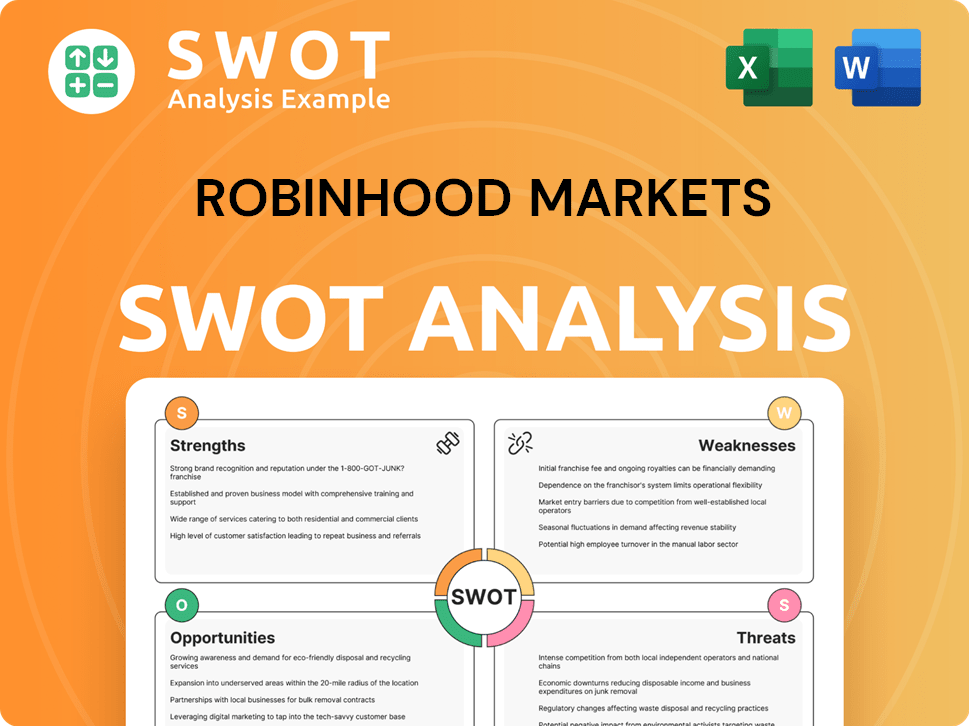
What Do Robinhood Markets’s Customers Want?
The key needs of the customers of the company are centered around easy access, simplicity, and control over their investments. A significant driver is the desire for commission-free trading, which eliminates a major cost barrier. Customers favor a streamlined, intuitive user experience, often preferring mobile-first platforms for managing their portfolios. These preferences shape the Robinhood user profile.
Customers are drawn to the platform for its ease of use, low costs, and the ability to invest in a diverse range of assets, including stocks, ETFs, and cryptocurrencies, all within a single application. This approach appeals to a broad spectrum of investors, especially those new to the market. The platform's focus on accessibility and a user-friendly interface makes it a popular choice for those looking to engage with financial markets.
Product usage patterns show a preference for frequent, often smaller, trades, indicating a more active and engaged retail investor base. Loyalty is tied to the platform's continued ease of use, competitive offerings, and the perception of democratizing finance. The company addresses common pain points such as high trading fees, complex interfaces of traditional brokers, and limited access to certain asset classes. This focus helps define the Robinhood target market.
The elimination of trading commissions is a primary motivator, attracting users who want to minimize costs. This feature is particularly appealing to those who make frequent trades or start with smaller investment amounts. Commission-free trading democratizes access to financial markets.
A simple and intuitive user interface is crucial, especially for new investors. The mobile-first design provides convenience and ease of use. This focus on user experience helps attract and retain customers.
Offering a wide range of investment options, including stocks, ETFs, and cryptocurrencies, caters to diverse investment strategies. This variety appeals to users with different risk profiles and investment goals. The addition of crypto trading has expanded the user base.
The mobile-first approach allows users to manage their investments anytime, anywhere. This accessibility is particularly attractive to younger, tech-savvy investors. Mobile trading is a key factor in user engagement.
Providing educational content helps users make informed investment decisions. Resources like market news, analysis, and tutorials enhance the user experience. These resources support informed decision-making.
Offering competitive features, such as fractional shares and recurring investments, enhances the platform's appeal. These features cater to different investment strategies and financial goals. Competitive offerings drive user loyalty.
Customer feedback and market trends, such as the increasing interest in cryptocurrency, have directly influenced product development, leading to the expansion of crypto offerings and the introduction of features like recurring investments. For example, the company has tailored its marketing to emphasize empowerment and financial freedom, using language and visuals that resonate with its younger, tech-savvy audience. The introduction of retirement accounts in 2024 further illustrates how the company is adapting to meet the evolving financial planning needs of its maturing customer base. The company's ability to adapt to market changes and customer preferences is a key factor in its success. For a broader view of the competitive landscape, consider exploring the Competitors Landscape of Robinhood Markets.
The company's success is driven by its ability to meet the needs of a diverse customer base. Understanding these preferences is crucial for continued growth and market leadership.
- Ease of Use: A simple and intuitive platform is a top priority for users, especially those new to investing.
- Low Costs: Commission-free trading and minimal fees are essential for attracting and retaining customers.
- Accessibility: Mobile-first design and 24/7 access to trading are critical for convenience.
- Investment Options: A wide range of assets, including stocks, ETFs, and cryptocurrencies, caters to diverse investment strategies.
- Educational Resources: Tools and information to help users make informed decisions.
Robinhood Markets PESTLE Analysis
- Covers All 6 PESTLE Categories
- No Research Needed – Save Hours of Work
- Built by Experts, Trusted by Consultants
- Instant Download, Ready to Use
- 100% Editable, Fully Customizable
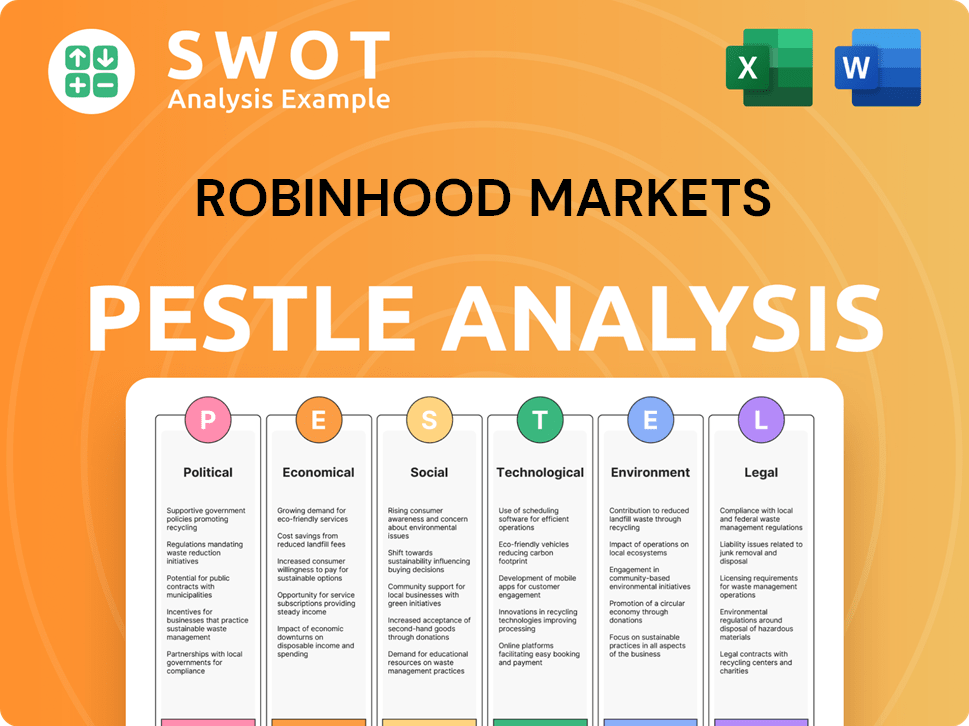
Where does Robinhood Markets operate?
The primary geographical market for Robinhood is the United States. The company has established a strong presence across the country, with a significant user base and brand recognition. Its focus remains firmly within the U.S. market as of early 2025, concentrating on expanding its product offerings and services within the existing geographical footprint.
Robinhood's customer base is spread nationally, with marketing efforts and user acquisition strategies designed for broad appeal. While specific regional breakdowns of user demographics or market share are not always publicly available, the company's approach suggests a standardized platform accessible to its target demographic throughout the U.S. This strategy contrasts with extensive localization for different states or cities.
The company's strategic focus has been on product diversification within the U.S. market rather than immediate international expansion for its core brokerage services. Any adjustments to its offerings or discontinuation of features primarily occur within the U.S. market. The geographic distribution of sales and growth is largely uniform across the U.S., driven by national marketing campaigns and overall trends in retail investing. To understand more about the company's growth strategy, you can read about the Growth Strategy of Robinhood Markets.
Within the U.S., customer demographics, preferences, and buying power may vary regionally. However, Robinhood's platform is designed to be universally accessible. The company aims to cater to its target demographic nationwide, rather than tailoring its offerings extensively to different states or cities.
Robinhood has prioritized product diversification within the U.S. market over immediate international expansion of its core brokerage services. Strategic decisions, such as refining product offerings or discontinuing features, have primarily occurred within the existing U.S. market. This approach reflects a focus on deepening its presence within its primary geographical area.
Robinhood Markets Business Model Canvas
- Complete 9-Block Business Model Canvas
- Effortlessly Communicate Your Business Strategy
- Investor-Ready BMC Format
- 100% Editable and Customizable
- Clear and Structured Layout
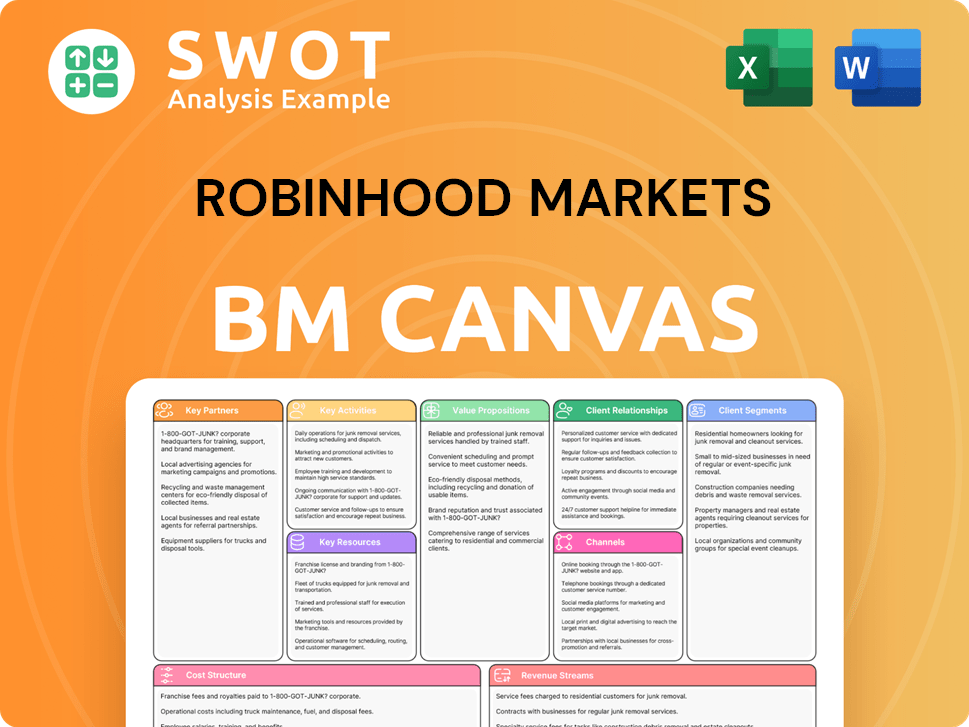
How Does Robinhood Markets Win & Keep Customers?
Customer acquisition and retention strategies are crucial for the success of any financial platform. For the platform, these strategies are heavily reliant on digital marketing and a user-friendly experience. Understanding the Robinhood user profile is essential for tailoring these strategies effectively.
The platform's initial growth was significantly fueled by viral marketing tactics and a robust referral program. This approach, combined with a focus on financial literacy and product features, helped attract a younger demographic. The company continues to refine its strategies, emphasizing customer engagement and providing educational resources to enhance user retention.
The company leverages customer data and CRM systems to segment its user base. This segmentation enables the platform to tailor marketing campaigns, product notifications, and educational content. Successful acquisition campaigns often coincide with increased interest in specific asset classes, such as the cryptocurrency surge.
The company heavily utilizes digital marketing channels, including social media, to reach its target audience. Social media content focuses on financial literacy, market trends, and product features. Influencer marketing also plays a role.
The referral program, offering free stock for sign-ups and referrals, was a key early growth driver. These programs helped accelerate user acquisition by leveraging existing users to attract new customers.
The platform primarily uses a self-service model through its mobile app and website. This approach minimizes the need for a traditional sales force, making it accessible to a broader audience.
Customer data and CRM systems are used to segment the user base for targeted marketing and personalized experiences. This data-driven approach helps tailor content and product offerings.
In terms of retention, the platform focuses on improving user experience, expanding product offerings, and providing responsive customer service. Over time, the company has put more emphasis on building trust and providing educational content, especially after periods of market scrutiny. These efforts aim to increase customer lifetime value and reduce churn rate by fostering a more engaged and informed user base. For more details on the business model, you can read about the Revenue Streams & Business Model of Robinhood Markets.
Continuous improvements to the platform's user interface and overall experience are a priority. This includes making the platform more intuitive and user-friendly to retain customers.
Expanding product offerings, such as retirement accounts and extended trading hours, keeps users engaged. Offering a diverse range of financial products encourages long-term use.
Providing responsive and helpful customer service is crucial for retaining users. Addressing issues promptly and effectively builds trust and loyalty.
Offering robust educational content helps users make informed decisions. This includes articles, videos, and tutorials on financial topics.
Loyalty programs and personalized experiences, such as offering interest on uninvested cash, enhance retention. These programs provide added value to users.
Building trust through transparency and reliability is essential. This includes addressing user concerns and being upfront about fees and risks.
Robinhood Markets Porter's Five Forces Analysis
- Covers All 5 Competitive Forces in Detail
- Structured for Consultants, Students, and Founders
- 100% Editable in Microsoft Word & Excel
- Instant Digital Download – Use Immediately
- Compatible with Mac & PC – Fully Unlocked
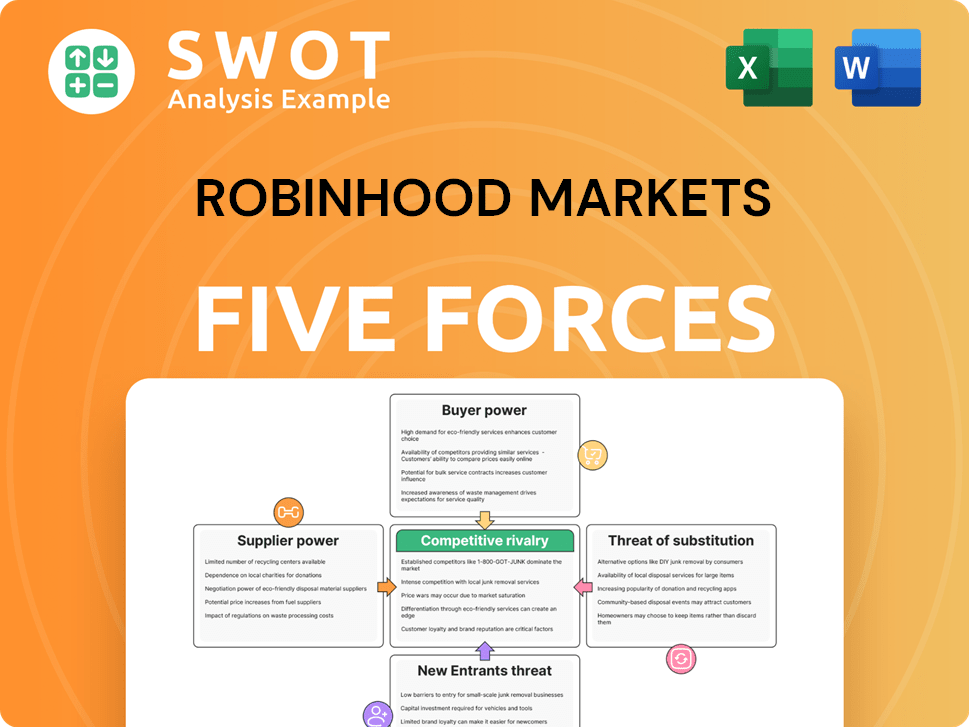
Related Blogs
- What are Mission Vision & Core Values of Robinhood Markets Company?
- What is Competitive Landscape of Robinhood Markets Company?
- What is Growth Strategy and Future Prospects of Robinhood Markets Company?
- How Does Robinhood Markets Company Work?
- What is Sales and Marketing Strategy of Robinhood Markets Company?
- What is Brief History of Robinhood Markets Company?
- Who Owns Robinhood Markets Company?
Disclaimer
All information, articles, and product details provided on this website are for general informational and educational purposes only. We do not claim any ownership over, nor do we intend to infringe upon, any trademarks, copyrights, logos, brand names, or other intellectual property mentioned or depicted on this site. Such intellectual property remains the property of its respective owners, and any references here are made solely for identification or informational purposes, without implying any affiliation, endorsement, or partnership.
We make no representations or warranties, express or implied, regarding the accuracy, completeness, or suitability of any content or products presented. Nothing on this website should be construed as legal, tax, investment, financial, medical, or other professional advice. In addition, no part of this site—including articles or product references—constitutes a solicitation, recommendation, endorsement, advertisement, or offer to buy or sell any securities, franchises, or other financial instruments, particularly in jurisdictions where such activity would be unlawful.
All content is of a general nature and may not address the specific circumstances of any individual or entity. It is not a substitute for professional advice or services. Any actions you take based on the information provided here are strictly at your own risk. You accept full responsibility for any decisions or outcomes arising from your use of this website and agree to release us from any liability in connection with your use of, or reliance upon, the content or products found herein.